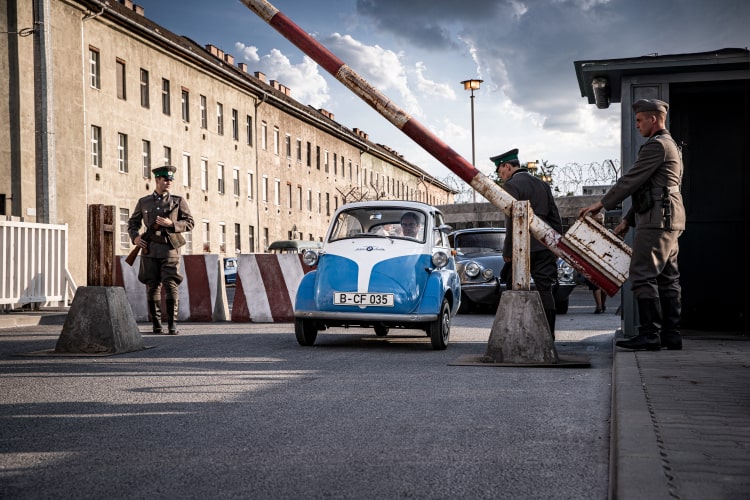The Quest for Freedom in the BMW Isetta
It was a bold plan: Klaus-Günter Jacobi assisted his best friend to escape East Germany by hiding him in a BMW Isetta as they went across the check-point on 23 May 1963.
The Berlin Wall Museum in Friedrichstrasse, Berlin, holds thousands of exhibits that serve as a reminder of the history of the city that was previously divided into an East and West, along with the people whose longing for freedom made them defy all odds.

On the upper floor of the museum, close to a window that watches over Checkpoint Charlie, sits a BMW Isetta, the smallest escape car ever used to cross the boder.
As a tourist guide, Klaus-Günter Jacobi guides visitors around the museum. Only a few people are aware, however, that not only is Jacobi knowledgeable about all the different escape attempts, but it was also actually his idea to use the tiny bubble car to hide a person while crossing the border. It was how he assited in his best friends escape from East to West Berlin.

More than 30 years after the fall of the Berlin Wall, BMW wanted to share the impressive story of Klaus-Günter Jacobi and his friend Manfred Koster daring escape from East Berlin in the Isetta.
The story was the source of the mini-movie “The Small Escape” which was produced by the BMW Group.
“The Small Escape” was set in 1964. It tells the story of how they risked all by turning a BMW Isetta into a vehicle to help stowaways cross the border. Director Alex Feil, set designer Erwin Prieb, and cameraman Khaled Mohtaseb produced the riveting story to bring it to the screen.

Jacobi and his family had already left East Berlin in 1958, three years before the Berlin wall was put in place. When his long-time friend, Manfred Koster, asked his assistance in him escaping from the GDR, he devised a creative plan of using his BMW Isetta as the escape vehicle.
The moto-coupé measures only 2.3 meters in length, and 1.4 meters in width, so he hoped that the minute size of the vehicle would arouse little suspicion from the border soldiers.
Even looking at the car today, it looks almost impossible to hide a person in a BMW Isetta. Even unmodified, the Isetta occupies two people in a very tight fit immediately behind the front door.
Jacobi built the hiding place for his friend behind the seat bench, next to the engine. As a car mechanic, Jacobi himself converted the car in his former training workshop in Berlin-Reinickendorf.

Modifications to the BMW Isetta required for the Escape
- The storage box located at the back of the seat was removed and then was welded 4 inches higher back in at a later stage. This allowed additional space for the stowaway and any modifications needed.
- The spare tire and seat were taken out and create a 20 x 20-inch opening hole within a piece of sheet metal that works as the back panel.
- The exhaust pipe cover is taken apart and removed along with the air filter and anything that takes up space that is unnecessary.
- The exhaust pipe is required to be bent to allow positioning of the stowaway.
- To stop the stowaway from being burnt by the heated exhaust a floor panel is fashioned out of sheet metal.
- Everything is sanded smooth once more and the rear fended has a part cut off it to prevent it from scraping the ground due to the stowaways’ weight.
- On the day of the escape, a large 3.5-gallon tank is removed from the gas hose, and in its place is a small canister the size of an oil can. This provides enough gas to get over the border with his friend.
Just before the border closed on midnight of May 23, 1964, the Klaus-Güter Jacobi converted BMW Isetta went through the opened barrier.
After crossing, he freed Manfred from the makeshift hiding place from behind the seat bench and hugged each other in joy.

Jacobi’s BMW Isetta was only used once as an escape car, but his achievement inspired others to do the same. In the following years, eight more GDR citizens were able to escape to the West in a similarly converted BMW Isetta.
Since their invention, automobiles have brought freedom and self-determination to humankind. Cars bring people together. This is something one should always also keep in mind in the current debate. The movie emphasizes this. The moving escape story with the BMW Isetta can also be seen as a symbol of the invaluable value cars and individual mobility can have. It’s all about freedom, independence, and dreams. Our movie recognizes the drive and courage of the people who made this successful escape possible.”
Head of BMW Brand Management, Jens Theimer.
The car is currently on display in the Berlin Wall Museum. The movie “The Small Escape” is also a permanent exhibit to commemorate the spectacular escape attempts.
[Source: BMW]











Great story.